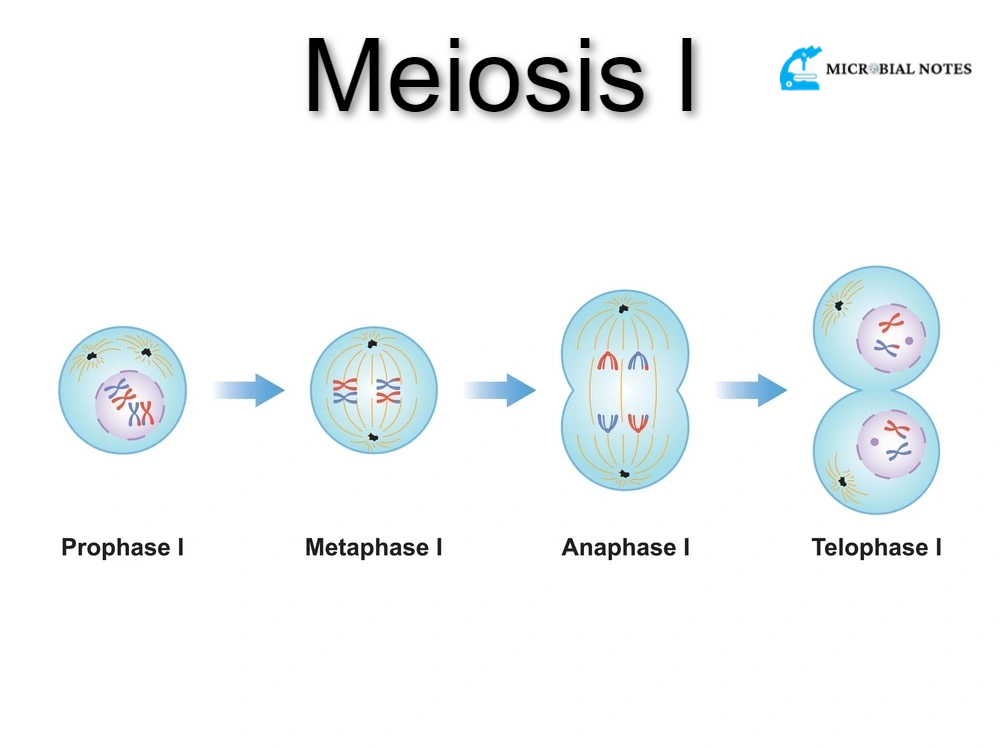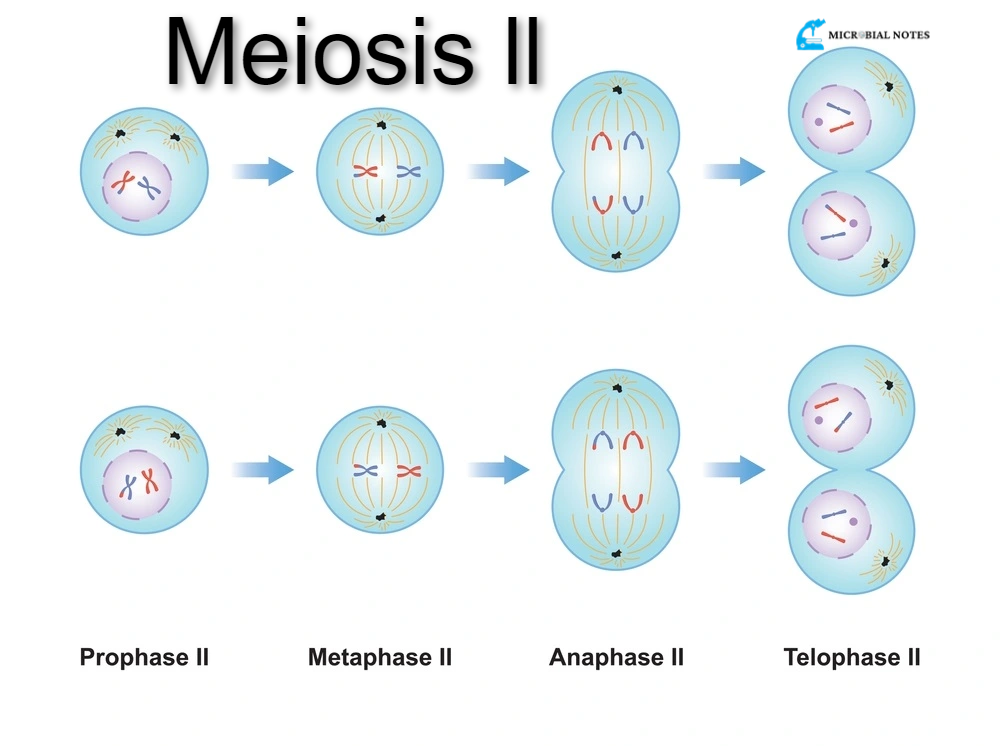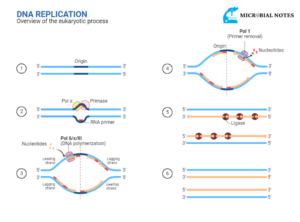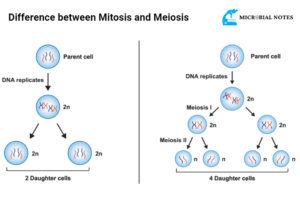Define meiosis
Eukaryotic cells (plants, animals, and fungi) reproduce sexually through a process called meiosis. Chromosome reduction is the process by which haploid cells are created from diploid cells, which are cells with two complete and identical sets of chromosomes. Germ cells, sometimes referred to as gametes, sex cells, or spores in plants and fungi, are haploid cells formed during meiosis. These are necessary for sexual reproduction because they result in the formation of a second, fully-formed adult of the same species when two germ cells combine to produce a diploid zygote.
To preserve a species’ chromosomal number, the chromosomal reduction process is crucial. The offspring would have a tetraploid chromosome set, or four identical sets of chromosomes if chromosome numbers were not reduced and each parent produced a diploid germ cell. Every generation would see a rise in this number. The chromosomal decrease is essential for the survival of each species because of this.
Meiosis is divided into two separate phases, I and II. There are many parallels and distinctions among these phases, each of which is equally important for the development of viable germ cells while also yielding a variety of products.
Meiosis l
Meiosis is a reduction type of cell division, whereas mitotic cell division is equational. The following are the key characteristics of meiotic division that set it apart from mitosis:-
- Meiosis I and Meiosis II are the two stages of the nuclear and cellular division where it takes place. However, DNA replication only happens once.
- It entails the pairing and recombination of homologous chromosomes.
- In contrast to mitosis, which produces two diploid daughter cells, four haploid daughter cells are created at the end.
The homologous pair of chromosomes are separated during meiosis 1, which also turns the diploid cell into a haploid. It is broken down into prophase, metaphase, anaphase, and telophase, among other stages.
Interphase
Interphase is divided into the following three stages:
Growth phase G1
The cell creates a wide variety of proteins during this extremely active phase, including the enzymes and structural proteins needed for growth and development.
Synthesis phase (S)
Each cell’s chromosome multiplies into two identical sister chromatids linked at a centromere as the genetic material is copied. The cell’s ploidy is unaffected by this replication since the number of centromeres stays the same. During prophase I of meiosis, the indistinguishable sister chromatids consolidate into the densely coiled chromosomes that are visible under a light microscope.
Growth phase G2
Meiosis does not have the G2 stage that is seen before mitosis.
Explain the phases of meiosis l
Prophase l
prophase I is divided into 5 substages and is longer than the mitotic prophase.
- Leptotene
- zygotene
- pachytene
- diplotene
- diakinesis
- During leptotene, the chromosomes start to condense and achieve a compact shape.
- The pairing of homologous chromosomes in zygotene initiates a process called chromosomal synapsis, which is followed by the development of a complex structure known as the synaptonemal complex. The bivalent or tetrad complex is made up of two homologous chromosomes that have synaptically joined.
- Non-sister chromatids of homologous chromosomes cross over at the recombination nodules during the pachytene stage. At the locations of crossing over, the chromosomes are still connected.
- Except at the sites of cross-over, diplotene indicates the breakdown of the synaptonemal complex and the separation of the bivalents’ homologous chromosomes. Chiasmata are the X-shaped structures that occur during separation.
- Chiasmata are terminated during diakinesis, and the meiotic spindle is assembled to segregate homologous chromosomes. The nuclear membrane disintegrates, and the nucleolus vanishes.
Metaphase l
At the cell’s center, homologous pairs of chromosomes line up on the equatorial plane. While ensuring that each chromosomal pair has half oriented to each pole, independent assortment controls the orientation of each bivalent. To prevent homologous chromosomes from ending up in the same cell, this is done. The sister chromatids’ arms are converging.
Anaphase l
In a process known as disjunction, microtubules start to shorten and tug one chromosome from each homologous pair to the opposing poles. Each chromosome’s sister chromatid maintains its connection. The cell starts to enlarge as it gets ready for cytokinesis.
Telophase l
When each homologous pair of chromosomes reaches the opposite poles of the cell, meiosis I am complete. Each haploid set of chromosomes is encircled by a fresh nuclear membrane once the microtubules break down. When the chromosomes uncoil, new chromatin is formed, and cytokinesis takes place, two distinct daughter cells are created. Some organisms go through an interkinesis or interphase II resting phase.

Meiosis ll
Haploids are created as a result of this process, which separates the sister chromatids within the two daughter cells. Similar to mitosis, this procedure results in only one set of homologous chromosomes being produced by each dividing cell.
Prophase ll
Once more, visible chromosomes are formed when chromatin condenses. Spindle fibers start to appear as the nuclear envelope and nucleolus start to fall apart. There is no crossing over.
Metaphase ll
Each sister chromatid’s kinetochore is connected by a spindle fiber. The equatorial plane, which is 90 degrees rotated from the equatorial plane in meiosis I, is where the chromosomes align. One sister chromatid with diverging arms faces each pole.
Anaphase ll
One sister chromatid is drawn to each pole as the spindle fibres attached to each sister chromatid shrink. From this point on, sister chromosomes are referred to as sister chromatids.
Telophase ll
When the sister chromosomes reach their opposite poles, meiosis II is complete. The chromosomes recoil and form chromatin when the spindle disintegrates. Before cytokinesis, which results in the formation of two daughter cells from each parent cell or four haploid daughter cells overall, a nuclear envelope forms surrounding each haploid chromosome set.

What is the significance of meiosis?
Animals reproduce by merging their gametes, or when two cells combine with their genetic material to form a zygote. The zygote will contain an increase of chromosomes in its nucleus if germ cells, which give rise to gametes, maintain their ploidy during division like somatic cells do.
Every next generation will see an increase in this stockpile. Meiosis, which reduces the number of chromosomes in the gametes to half of their parent germ cells, provides a really clever solution to this issue. Furthermore, homologous chromosomes can recombine during meiosis prophase I. The genetic variety of the gametes must be introduced by this recombination in order for evolution to occur through natural selection.
Also read: Similarities and Differences between mitosis and meiosis
References
https://byjus.com/biology/meiosis-ll-cell-division/
https://byjus.com/biology/meiosis-1-stages-and-process/
https://www.vedantu.com/biology/meiosis-1-stages-and-process
https://www.albert.io/blog/difference-between-meiosis-i-and-meiosis-ii/







